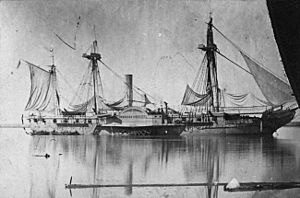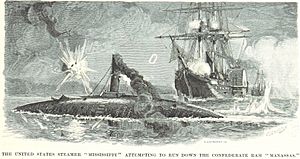USS Mississippi (1841) facts for kids
 |
|
Quick facts for kids History |
|
|---|---|
| Name | USS Mississippi |
| Builder | Philadelphia Navy Yard |
| Laid down | 1839 |
| Launched | 1842 |
| Commissioned | 22 December 1841 |
| Fate | Scuttled, 14 March 1863 |
| General characteristics | |
| Type | steam frigate |
| Displacement | 3,220 long tons (3,272 t) |
| Length | 229 ft (70 m) |
| Beam | 40 ft (12 m) |
| Depth of hold | 19 ft (5.8 m) |
| Propulsion | Steam engine |
| Speed | 8 knots (15 km/h; 9.2 mph) |
| Armament |
|
The USS Mississippi was a special kind of ship called a paddle frigate. She was the very first ship in the United States Navy to be named after the famous Mississippi River. Her sister ship was the Missouri.
The Mississippi was built at the Philadelphia Naval Shipyard starting in 1839. A famous naval officer, Commodore Matthew C. Perry, personally oversaw her construction. She officially joined the Navy on December 22, 1841, with Captain W. D. Salter in charge. She was launched into the water a few weeks later.
Contents
Adventures of the USS Mississippi
Early Years and Steam Power
For several years, the Mississippi served in the Home Squadron. During this time, she helped the Navy learn a lot about how to use steam power on ships. This was very important for making new, modern ships.
In 1845, she became the main ship for Commodore Perry in the West Indian Squadron.
Fighting in the Mexican-American War
The Mississippi played a big part in the Mexican–American War. She helped in attacks against several Mexican cities like Alvarado and Tampico. These actions helped the American forces control the Mexican coast. This stopped supplies from reaching the Mexican army by sea.
After getting repairs, the Mississippi arrived at Veracruz in March 1847. She brought Commodore Perry to take command of the American fleet there. The ship and her crew helped a lot in the attack on Veracruz. They even brought their big guns ashore to help fight the city. The city surrendered in just four days. For the rest of the war, the Mississippi helped with many coastal raids. She also took part in capturing Tabasco in June 1847.
Journey to Japan
From 1849 to 1851, the Mississippi sailed around the Mediterranean Sea. In 1851, she ran aground near Smyrna in the Ottoman Empire. This happened while she was going to pick up Lajos Kossuth to take him to the United States. Other ships tried to help her, but it was hard to get her free. She was finally refloated.
After this, the Mississippi got ready for Commodore Perry's famous Perry Expedition to Japan. She was the main ship for this important trip. Captain Sydney Smith Lee commanded her. The group of ships left the United States in November 1852. They sailed to places like Madeira, the Cape of Good Hope, Hong Kong, and Shanghai. They reached Shanghai in May 1853.
The ships then sailed to Japan, stopping at the Ryukyu Islands and Bonin Islands. They entered Edo Bay on July 8, 1853. They stayed there until the Japanese leaders accepted an official letter from President Millard Fillmore on July 14.
After more sailing in the Far East, the Mississippi and the other ships returned to Japan in February 1854. They stayed there to show American strength until the Convention of Kanagawa was signed on March 31. This treaty opened Japan to trade with the United States.
The Mississippi returned to New York City in April 1855. She sailed back to the Far East in August 1857. Her job was to help protect America's growing trade in Asia. As the main ship for Commodore Josiah Tattnall III, she was there when British and French forces attacked Chinese forts at Taku in June 1859. A few months later, her crew helped restore order in Shanghai when the city had civil unrest. She returned to Boston, Massachusetts, in January 1860. She was brought back into service when the American Civil War was about to begin.
Service in the Civil War
The Mississippi arrived off Key West, Florida, in June 1861. Her job was to help blockade the area. A few days later, she captured her first ship, the schooner Forest King. This ship was carrying coffee from Rio de Janeiro to New Orleans, Louisiana. In November 1861, she helped capture another British ship, the Empress, also carrying coffee to New Orleans.
The next spring, she joined Admiral David Farragut's fleet. They planned to attack New Orleans. On April 7, 1862, the Mississippi and Pensacola successfully crossed a sandbar at Southwest Pass. They were the heaviest ships to ever enter the Mississippi River at that time.
As Farragut's fleet moved up the river, they fought a key battle against Fort Jackson and Fort Saint Philip on April 24, 1862. During this fight, the Mississippi chased the Confederate ram Manassas ashore. She then destroyed the Manassas with two powerful attacks. A sailor named Christopher Brennan earned the Medal of Honor for his bravery in this battle.
New Orleans was now open to the Union forces. The Mississippi stayed near New Orleans for much of the next year. Her deep bottom made her less useful for operations further up the river.
The Final Battle at Port Hudson
The Mississippi was ordered to go upriver for an attack on Port Hudson, Louisiana. On March 14, 1863, she tried to pass the forts protecting Port Hudson. But she got stuck in the mud. The enemy forts began firing at her.
Captain Melancton Smith and his executive officer George Dewey (who later became a famous admiral) tried very hard to get her unstuck. But they couldn't. To stop the Confederates from capturing her, they destroyed her engines and guns. Then, they set her on fire. When the fire reached her ammunition storage, she exploded and sank.
Three of the Mississippi's men, Seaman Andrew Brinn, Boatswain's Mate Peter Howard, and U.S. Marine Corps Sergeant Pinkerton R. Vaughn, received the Medal of Honor for their brave actions during this time. The Mississippi lost 64 men, but other ships saved 223 of her crew.
See also
 In Spanish: USS Mississippi (1841) para niños
In Spanish: USS Mississippi (1841) para niños


